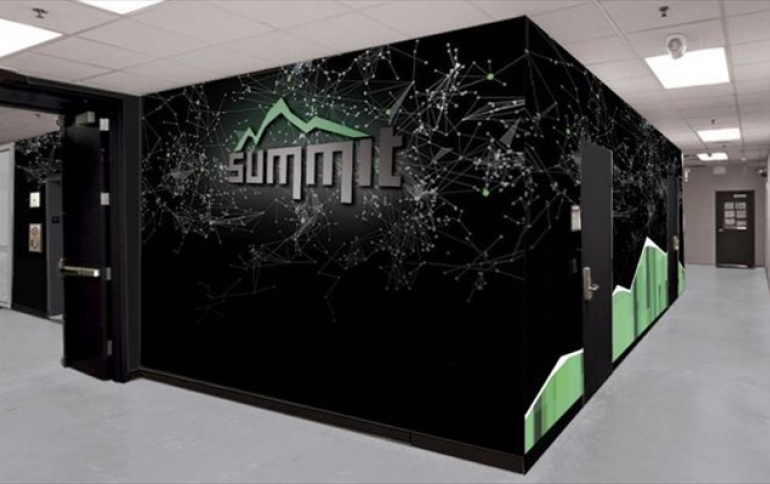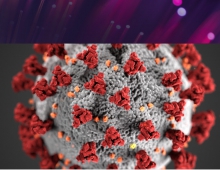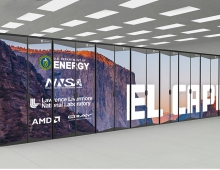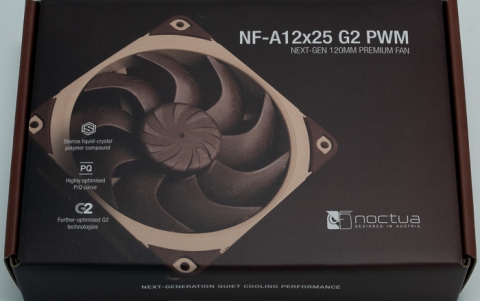
TOP500 Becomes a Petaflop Club for Supercomputers
The 53rd edition of the TOP500 supercomputer list marks a milestone: all 500 systems deliver a petaflop or more on the High Performance Linpack (HPL) benchmark, with the entry level to the list now at 1.022 petaflops.
Top 10 rundown
The top of the list remains largely unchanged, with only two new entries in the top 10, one of which was an existing system that was upgraded with additional capacity.
Two IBM-built supercomputers, Summit and Sierra, installed at the Department of Energy’s Oak Ridge National Laboratory (ORNL) in Tennessee and Lawrence Livermore National Laboratory in California, respectively, retain the first two positions on the list. Both derive their computational power from Power 9 CPUs and NVIDIA V100 GPUs. The Summit system slightly improved its HPL result from six months ago, delivering a record 148.6 petaflops, while the number two Sierra system remains unchanged at 94.6 petaflops.
The Sunway TaihuLight, a system developed by China’s National Research Center of Parallel Computer Engineering & Technology (NRCPC) and installed at the National Supercomputing Center in Wuxi, holds the number three position with 93.0 petaflops. It’s powered by more than 10 million SW26010 processor cores.
At number four is the Tianhe-2A (Milky Way-2A) supercomputer, developed by China’s National University of Defense Technology (NUDT) and deployed at the National Supercomputer Center in Guangzhou. It used a combination of Intel Xeon and Matrix-2000 processors to achieve an HPL result of 61.4 petaflops.
Frontera, the only new supercomputer in the top 10, attained its number five ranking by delivering 23.5 petaflops on HPL. The Dell C6420 system, powered by Intel Xeon Platinum 8280 processors, is installed at the Texas Advanced Computing Center of the University of Texas.
At number six is Piz Daint, a Cray XC50 system installed at the Swiss National Supercomputing Centre (CSCS) in Lugano, Switzerland. It’s equipped with Intel Xeon CPUs and NVIDIA P100 GPUs. Piz Daint remains the most powerful system in Europe.
Trinity, a Cray XC40 system operated by Los Alamos National Laboratory and Sandia National Laboratories improves its performance to 20.2 petaflops, which earns it the number seven position. It’s powered by Intel Xeon and Xeon Phi processors.
The AI Bridging Cloud Infrastructure (ABCI) is installed in Japan at the National Institute of Advanced Industrial Science and Technology (AIST) and is listed at number eight, delivering 19.9 petaflops. The Fujitsu-built system is equipped with Intel Xeon Gold processors and NVIDIA Tesla V100 GPUs.
SuperMUC-NG is in the number nine position with 19.5 petaflops. It’s installed at the Leibniz-Rechenzentrum (Leibniz Supercomputing Centre) in Garching, near Munich. The Lenovo-built machine is equipped with Intel Platinum Xeon processors, as well as the company’s Omni-Path interconnect.
The upgraded Lassen supercomputer captures the number 10 spot, with an upgrade that boosted its original 15.4 petaflops result on HPL to 18.2 petaflops. Installed at Lawrence Livermore National Laboratory, Lassen is the unclassified counterpart to the classified Sierra system and shares the same IBM Power9/NVIDIA V100 GPU architecture.
China leads by sheer numbers, US by performance
China claims the most TOP500 systems, with 219, followed by the United States, with 116. Japan is in third place with 29 systems, followed by France, with 19, the United Kingdom, with 18, and Germany with 14.
Despite the US being a distant second in total number of systems, it claims a large number of systems near the top of the list. That enables it to maintain its lead in overall HPL capacity, with 38.4 percent of the aggregate list performance. (Summit and Sierra, alone, represent 15.6 percent of the list’s HPL flops.) China, with its comparatively smaller systems, takes second place, with 29.9 percent of the performance total.
Chinese vendors lead the way
China’s dominance in system numbers is also reflected in vendor shares. Lenovo claims the greatest number of systems on the list, with 173, followed by Inspur with 71, and Sugon, with 63. All three improved on their system share from six months ago.
HPE, with 40 systems, and Cray, with 39 systems, occupy fourth and fifth place, respectively. Bull, as the only European-based system vendor on the list, claims 21 systems, followed by Fujitsu, with 13, and IBM, with 12. However, since IBM is the vendor of Summit, Sierra, and a number of other large systems, the company’s aggregate TOP500 performance is 207 petaflops, a number only exceeded by Lenovo, with 14 times as many systems.
Intel and NVIDIA set the pace in silicon
From a processor perspective, Intel continues to dominate the TOP500 list, with the company’s chips appearing in 95.6 percent of all systems. IBM Power CPUs are in seven systems, followed by AMD processors, which are present in three systems. A single supercomputer on the list, Astra, is powered by Arm processors.
A total of 133 systems on the TOP500 list employ accelerator or coprocessor technology, down slightly from 138 six months ago. Of these, 125 systems use NVIDIA GPUs. About half of those (62) using the latest Volta-generation processors, with the remainder (60) based on Pascal and Kepler technology.
Interconnects – a mixed bag
From an interconnect perspective, Ethernet continues to dominate the list overall, laying claim to 54.2 percent of TOP500 systems. InfiniBand is the second most popular interconnect, appearing in 25 percent of systems, followed by custom and proprietary interconnects at 10.8 percent, and Omni-Path at 9.8 percent.
However, when looking at the 50 fastest supercomputers on the list, those numbers change dramatically, with custom interconnects being used in 40 percent of the top systems, followed by InfiniBand at 38 percent, Omni-Path at 10 percent, and Ethernet at 2 percent (a single system).
Green500 results
Turning to the related Green500 list, energy efficiency hasn’t moved much since the previous list was released in November 2018. The Shoubu system B maintains its number one position with an efficiency of 17.6 gigaflops/watt. Nvidia’s DGX SaturnV Volta system holds on to second place with 15.1 gigaflops/watt, followed by Summit at 14.7 gigaflops/watt and the AI Bridging Cloud Infrastructure (ABCI) at 14.4 gigaflops/watt. The MareNostrum P9 CTE cluster improved its result from six month ago to capture the fifth position with 14.1 gigaflops/watt. Overall, the average energy efficiency of systems on the Green500 list has improved from 3.0 gigaflops/watt, six months ago, to 3.2 gigaflops today.
HPCG results
The benchmark results for High-Performance Conjugate Gradient (HPCG) Benchmark were largely unchanged from last November, with the top five entries of Summit, Sierra, the K computer, Trinity, and the AI Bridging Cloud Infrastructure maintaining their previous rankings from November 2018. Summit and Sierra remain the only two systems to exceed a petaflop on the HPCG benchmark, delivering 2.9 petaflops and 1.8 petaflops, respectively. The average HPCG result on the current list is 213.3 teraflops, a marginal increase from 211.2 six months ago.




















